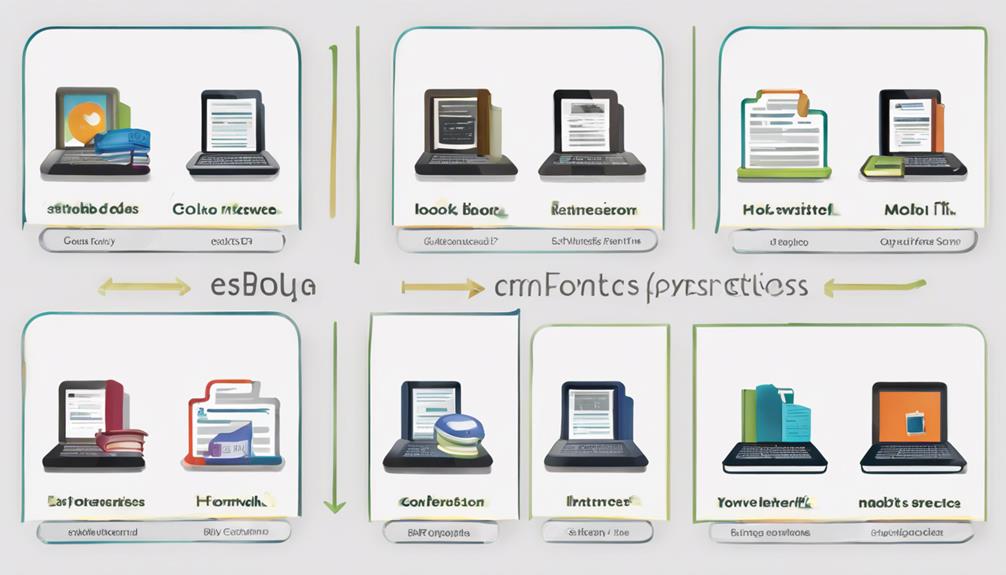To convert your manuscript into an ebook, the process can be both challenging and rewarding. Before you dive into the digital realm, there are crucial considerations to ponder. From selecting the right conversion service to fine-tuning design elements, each step plays a vital role in the journey of transforming your words into a captivating ebook. Let’s explore the intricacies of this conversion process together, ensuring your manuscript comes to life in the digital world seamlessly.
Select a Conversion Service
When it comes to converting your manuscript into an ebook, selecting a conversion service is a crucial step in ensuring a seamless transition from print to digital format. The first aspect to consider when choosing a conversion service is the pricing options they offer. Compare different services to find one that fits your budget while still providing quality results.
Quality standards are another essential factor to keep in mind when selecting a conversion service. Look for companies that have a proven track record of producing ebooks with high-quality formatting, images, and text that are optimized for various e-reader devices. Reading reviews and requesting samples of their previous work can give you insight into the level of quality you can expect.
Ultimately, the conversion service you choose should offer competitive pricing options without compromising on quality standards. By conducting thorough research and selecting a reputable service that meets both criteria, you can ensure that your manuscript is converted into an ebook professionally and effectively.
Prepare Your Manuscript
To embark on the process of preparing your manuscript for conversion into an ebook, the initial step is to ensure that your document is in a digital format. Once you have your manuscript in a digital form, it’s crucial to focus on formatting tips and the editing process to ensure a smooth transition to an ebook.
Formatting tips play a vital role in the readability and overall appearance of your ebook. Make sure to use a consistent font throughout the manuscript, such as Times New Roman or Arial, to maintain a professional look. Additionally, consider adjusting the font size and spacing to enhance readability on various devices.
The editing process is equally important when preparing your manuscript. Proofread your content multiple times to catch any grammatical errors, typos, or inconsistencies. Consider seeking feedback from beta readers to gain valuable insights and make necessary revisions.
Decide on the Ebook Format
Consideration of the ebook format is a pivotal step in the journey of converting your manuscript into a digital masterpiece. When deciding on the ebook format, you must consider various factors such as formatting options, compatibility considerations, cover design, and file size restrictions.
Formatting options play a crucial role in how your ebook will appear on different devices. Choosing a format that supports your desired layout and design elements is essential to ensure a seamless reading experience for your audience. Additionally, consider compatibility considerations to ensure your ebook can be accessed on a wide range of devices and platforms without any issues.
Moreover, cover design is another aspect to think about when selecting the ebook format. Some formats may support interactive or high-resolution cover images, while others may have limitations in this regard. Make sure the format you choose aligns with your design preferences and requirements.
Lastly, keep file size restrictions in mind to ensure that your ebook file remains within acceptable limits for distribution and download purposes. Balancing quality and file size is key to creating an optimal reading experience for your audience.
Specify Design and Layout Preferences
For a successful transition from manuscript to ebook, detailing your design and layout preferences is crucial. When specifying your preferences, consider elements such as cover design and font selection. The cover design is the first thing readers see, so it should be eye-catching and relevant to the content of your book. You can opt for a professionally designed cover or create one yourself using online tools.
Font selection is another important aspect to consider. Choose a font that is easy to read on various devices and sizes. Common choices include serif fonts like Times New Roman for printed books, but for ebooks, sans-serif fonts like Arial or Verdana are recommended for better readability on screens.
When specifying your design and layout preferences, be clear about the overall look and feel you want to achieve. Communicate any specific color schemes, image placements, or text formatting preferences. Providing detailed instructions will help ensure that your ebook is converted to meet your expectations.
Submit Manuscript for Conversion
When preparing to move forward with the conversion process, the next step involves submitting your manuscript for conversion. To ensure a smooth transition from manuscript to ebook, pay attention to formatting tips. Make sure your document is properly formatted with consistent fonts, spacing, and alignment. Avoid using multiple font styles or sizes as they may cause issues during the conversion process.
Common mistakes to avoid when submitting your manuscript for conversion include forgetting to remove any special formatting such as headers, footers, or page numbers. These elements can disrupt the flow of your ebook. Additionally, failing to check for any spelling or grammar errors before submission can result in a less polished final product.
Before submitting your manuscript, double-check that all images and graphics are high quality and embedded properly within the document. This will help ensure that the visual elements of your ebook translate effectively in the digital format. By following these formatting tips and avoiding common mistakes, you can streamline the conversion process and enhance the overall quality of your ebook.
Review First Draft, Make Revisions
After receiving the first draft of your converted ebook, it is essential to meticulously review the content and make necessary revisions for a polished final product. Begin by engaging in a thorough feedback process with your editor or beta readers. Take note of their comments and suggestions regarding clarity, structure, and overall readability.
When reviewing the first draft, pay close attention to areas that may need improvement, such as grammar, punctuation, and consistency in formatting. Make sure that the content flows smoothly and that there are no abrupt transitions or confusing sections. Address any editing suggestions provided by your editor or readers, and consider how these changes can enhance the overall quality of your ebook.
As you make revisions, keep your target audience in mind and strive to create a compelling and engaging reading experience. Take the time to refine your writing style, tighten up any loose ends, and polish the content until it shines. By actively participating in the editing process and incorporating valuable feedback, you can ensure that your ebook is well-crafted and ready to captivate readers.
Frequently Asked Questions
Can I Include Multimedia Elements Like Videos in My Ebook?
Yes, you can include multimedia elements like videos in your ebook. Adding interactive features enhances reader engagement. Be mindful of copyright concerns and ensure accessibility. Multimedia elements can enrich the reading experience and make your ebook more dynamic.
How Can I Prevent Piracy of My Ebook After Conversion?
Protect your ebook like a fortress. Implement robust eBook security measures to prevent piracy. Utilize anti-piracy tools and encryption techniques for maximum protection. Stay vigilant and proactive in safeguarding your literary creation from unauthorized distribution.
Is It Possible to Convert a Handwritten Manuscript Into an Ebook?
Yes, it’s possible to convert a handwritten manuscript into an ebook using OCR technology. Start by digitizing your manuscript through scanning tech. OCR software will then convert the scanned text into a digital format for your ebook.
Can I Use a Pen Name for My Ebook Without Revealing My Identity?
Yes, you can use a pen name for your ebook, ensuring author anonymity. It’s a common practice, with studies showing that over 30% of authors opt for pseudonyms. Protect your identity while sharing your work.
Will My Ebook Be Compatible With All E-Reader Devices?
Your ebook’s compatibility with e-reader devices ensures a seamless reading experience for your audience. Incorporating multimedia elements can enhance engagement but may impact compatibility. Consider your target readers’ devices to optimize accessibility and user experience.



